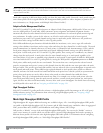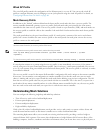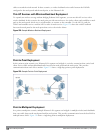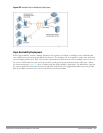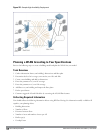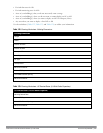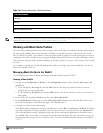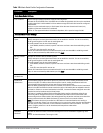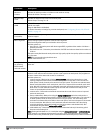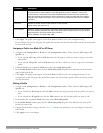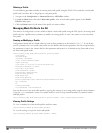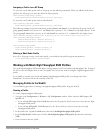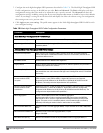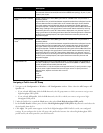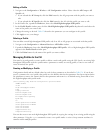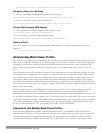
452 | SecureEnterpriseMesh DellPowerConnectW-SeriesArubaOS6.2 | User Guide
Parameter Description
Maximum
Children
Indicates the maximum number of children a mesh node can accept.
Default: 64 children. The range is 1–64.
Maximum Hop
Count
Indicates the maximum hop count from the mesh portal.
Default: 8 hops. The range is 1–32.
Mesh Private
VLAN
A VLAN ID for control traffic between an remote mesh portal and mesh nodes. This VLAN ID must not be
used for user traffic.
Range: 0–4094. Default: 0 (disabled).
For further information on configuring a remote mesh portal, see "Configuring Remote Mesh Portals
(RMPs)" on page 471
Mesh
Survivability
This feature is currently not supported and should only be enabled under the supervision of Dell
technical support.
Metric algorithm Use this setting to optimize operation of the link metric algorithm.
Specifies the algorithm used by a mesh node to select its parent.
Available options are:
l best-link-rssi—Selects the parent with the strongest RSSI, regardless of the number of children a
potential parent has.
l distributed-tree-rssi—Selects the parent based on link-RSSI and node cost based on the number of
children.
This option evenly distributes the mesh points over high quality uplinks. Low quality uplinks are selected
as a last resort.
NOTE: Dell recommends using the default value.
Default: distributed-tree-rssi.
Rate Optimization
for delivering
EAPOL frames
and mesh echoes
When this parameter is enabled, EAPOL frames, mesh echo requests and echo responses are sent at a
lower rate.
Reselection mode Use this setting to optimize operation of the link metric algorithm. The reselection mode specifies the
method a mesh node uses to find a better uplink to create a path to the mesh portal. Only neighbors on
the same channel in the same mesh cluster are considered.
Available options are:
l reselect-anytime—Mesh points using the reselect-anytime reselection mode perform a single
topology readjustment scan within 9 minutes of startup and 4 minutes after a link is formed. If no
better parent is found, the mesh point returns to its original parent. This initial scan evaluates more
distant mesh points before closer mesh points, and incurs a dropout of 5–8 seconds for each mesh
point. After the initial startup scan is completed, connected mesh nodes evaluate mesh links every
30 seconds. If a mesh node finds a better uplink, the mesh node connects to the new parent to
create an improved path to the mesh portal.
l reselect-never—Connected mesh nodes do not evaluate other mesh links to create an improved
path to the mesh portal.
l startup-subthreshold—Mesh points using the startup-subthreshold reselection mode perform a
single topology readjustment scan within 9 minutes of startup and 4 minutes after a link is formed. If
no better parent is found, the mesh point returns to its original parent. This initial startup scan
evaluates more distant mesh points before closer mesh points, and incurs a dropout of 5–8 seconds
for each mesh point. After that time, each mesh node evaluates alternative links if the existing
uplink falls below the configured threshold level (the link becomes a sub-threshold link). Dell
recommends using this default startup-subthreshold value.
l subthreshold-only—Connected mesh nodes evaluate alternative links only if the existing uplink
becomes a sub-threshold link.
NOTE: Starting with ArubaOS 3.4.1, if a mesh point using the startup-subthreshold or subthreshold-only
mode reselects a more distant parent because its original, closer parent falls below the acceptable
threshold, then as long as that mesh point is connected to that more distant parent, it seeks to reselect a



